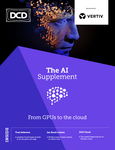The advent of AI-based solutions is fueling a data-driven landscape where the demand for faster processing has reached a tipping point, placing a significant strain on traditional IT infrastructure. These devices – deployed everywhere from factories to hospitals to smart cities – capture real-time data at an unprecedented scale, while powering AI-based applications including intelligent machine vision, digital twins, autonomous vehicles, and more. And it’s not slowing down any time soon. IDC estimates there will be approximately 41.6 billion IoT devices, generating up to 79.4 zettabytes of data, by 2025.
As data creation continues to surge, corporate networks need help managing all kinds of AI applications in the enterprise. Low latency between applications at the Edge and the cloud results in slow computations – this is a critical challenge when use cases need immediate action e.g. safety use case inside an airport hangar. Enterprises also face increased costs from backhauling large amounts of data both from an infrastructure and cost-per-gigabyte of storage. This is especially true for the manufacturing and industrial sectors.
Amidst this challenge lies a solution, the intelligent Edge or Edge AI, forming a critical pillar of Industry 4.0 that is poised to revolutionize industrial automation and enhance real-time, data-driven insights.
Edge computing and Edge AI
Edge computing, with its localized processing power and storage, offers a practical approach to overcoming the limitations of cloud architecture. It brings processing power and storage closer to data sources on local devices, enabling enhanced security.
Edge AI, or smaller and more lightweight, bespoke AI models deployed on Edge devices, capitalizes on Edge computing capabilities by enabling these new specialized devices to process vast amounts of data from multiple devices and endpoints. This allows them to all speak the same language which enables 'Actionable AI’ in the given environment and thus faster, more autonomous decision-making. For instance, intelligent machine vision systems in manufacturing can analyze and react to visual data on-site, reducing the lag that would occur if data had to be sent to and processed in the cloud from multiple devices across multiple systems.
Businesses see the promise of Edge and leverage IoT and private 5G technologies to drive efficiencies across various sectors through automation. With 70 percent of businesses actively adopting Edge technologies, enterprises are recognizing the potential to drive Industry 4.0 transformation while enhancing resiliency in their operations. Organizations are already seeking out these Edge solutions, including leveraging modular data centers on-site to bring data management, processing, and collection to challenging and remote sites where reliable, high bandwidth connectivity is a challenge for most in the manufacturing vertical.
Driving efficiencies with private 5G and IoT technologies
The advantages of intelligent Edge are powered by fast, reliable, and secure connectivity solutions such as private 5G networks. These networks provide a robust and secure infrastructure for connecting IoT devices, ensuring seamless communication and data transfer between Edge devices and central systems. These technologies support the much-anticipated revolution in industrial automation and data-driven decision-making.
Combining these technologies offers several key advantages for today's increasingly distributed enterprises:
- Enhanced security: Centralized data storage presents a single point of failure, making it a prime target for cyberattacks. Edge computing allows for local data processing, minimizing the attack surface and reducing the potential for large-scale data breaches.
- Actionable AI: Combining Edge computing with Edge AI allows for faster data processing and Actionable AI, improving performance in critical applications, where identifying and addressing equipment issues early can prevent costly downtime.
- Increased resiliency: Edge computing systems often operate with some degree of autonomy, making them less susceptible to network outages that can cripple centralized systems.
- Improved safety: Safety is critical to real-time applications at the Edge. Leveraging these technologies unlocks new solutions to identify unauthorized users in unsafe environments.
Early adopters in sectors like manufacturing, transportation and logistics, and healthcare, are already reaping the rewards. They're focusing on applications that improve employee safety, customer experience, and operational efficiency. While motivations differ, real-time data access, automation/AI, operational efficiency, and IoT device management have been identified as the top drivers behind Edge investment.
The compatibility challenge
Despite the benefits, the sheer variety of devices, protocols, and platforms in the IoT landscape creates a significant compatibility hurdle. Businesses are hesitant to invest in Edge solutions that might not integrate seamlessly with their current infrastructure or future deployments.
However, to truly realize the promise of Edge computing and Edge AI, enterprises need to modernize their networks. Reliable connections and low-latency environments are essential for data movement and real-time data processing required by AI-based solutions.
What’s clear is that the promise of Edge will drive companies to improve their network infrastructure so that they can take advantage of local, real-time compute and solutions. In fact, Almost 40 percent of enterprises planning Edge deployments acknowledge a need to upgrade their network to support the expected spike in connected devices and the demands of new applications.
Building a successful Actionable AI journey
Successful Edge deployments drive businesses to treat it as an integral part of their business strategy. Meeting the data demands of the latest AI-powered innovations isn't a one-person job. What’s clear is that AI is driving the demand for Edge technologies. To meet this demand, organizations will need to collaborate internally between IT and business teams, and externally with managed service providers (MSPs) who can help navigate legacy systems and protocols. Leveraging the knowledge of MSPs will be integral to finding the most efficient and effective ways for an enterprise to deploy and leverage Edge computing.
By embracing the intelligent Edge, businesses can unlock a myriad of benefits from operational efficiency to real-time Actionable AI – the perfect foundation for agile and adaptable operations. As more enterprises look to adopt the latest Edge technologies, this foundation will be critical to ensuring seamless data processing, scalability, and the ability to adapt to evolving business goals, but this demands orchestration across IT and business functions. Keep in mind that going in alone on the journey can prevent enterprises from realizing the full potential of Edge. Embrace collaboration, harness the power of the intelligent Edge, and watch Industry 4.0 aspirations transform into reality.





